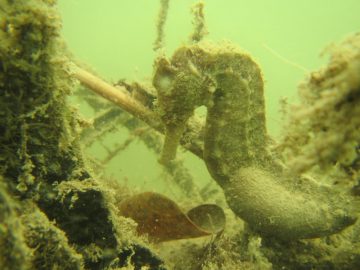
Dr. Amanda Vincent
Project Seahorse, a marine conservation research unit based at the University of British Columbia’s Institute for the Oceans and Fisheries, is applauding Thailand’s decision to end seahorse exports until it can trade in a sustainable manner, without damaging their wild populations. We spoke to Dr. Amanda Vincent, Director, Project Seahorse and Professor, Institute for the Oceans and Fisheries about the decision.
Thailand has announced it is suspending seahorse exports. What does this mean?
Thailand is by far the world’s largest exporter of wild seahorses, representing 90% of the trade. What they announced at today’s CITES (Convention on International Trade in Endangered Species of Wild Fauna and Flora) meeting is that they have decided to suspend all of its international trade in these quirky fishes until it can sort out an effective, sustainable way to sell them abroad without damaging their wild populations.
This trade suspension means that the country will stop exporting seahorses, probably for several years, but will one day return to international trade in seahorses.
What role did Project Seahorse play in achieving this trade ban?
The Project Seahorse team, based at UBC and with its partner, the Zoological Society of London, played a major role in assisting Thailand to tackle this important conservation issue head on.
Our work on the international level has been pioneering; we are the globally recognized expert group on 350 species of fish (seahorses, pipefishes, sea dragons and their relatives), and we worked with CITES to develop the first ever global trade agreement regulations the export of marine fishes.
At the request of CITES, Project Seahorse worked with Thailand’s Department of Fisheries on tools and approaches for export management, as well as studying Thailand’s seahorse populations, fisheries and trades. Meeting CITES recommendations on the complex and very large trade in these animals was a big challenge, and we understand why Thailand has decided that a trade suspension would allow it more time to get export regulations right. Now we are eager to help Thailand obtain what it needs in terms of tools, resources, and support to manage seahorse exports sustainably.
How large is the international trade in seahorses?
It is large and complex, estimated at more than tens of millions of individuals per year, involving more than 80 countries, and more than 41 species. The majority of exports come from Southeast Asia or West Africa, with Mainland China, Hong Kong, and Taiwan as the primary importers. Seahorses are used primarily in dried form for traditional medicine, live in ornamental aquarium displays, and as curios and souvenirs.
Thailand is by far the world’s most significant exporter of seahorses; the source of more than three-quarters of the seahorse in international trade each year. Official CITES data show that Thailand has exported about 5 million animals per year since 2004, all of them dried and all of them wild. Our analysis of Thailand’s fisheries suggests the real numbers are actually much higher.

Hippocampus kuda. Photo: Lindsay Aylesworth/
Project Seahorse
Which species will be impacted by this move?
Seven species of seahorses inhabit Thailand’s national waters. Five have been recorded in trade, and four (Hippocampus kelloggi,, Hippocampus kuda, Hippocampus spinosissimus, and Hippocampus trimaculatus) dominate global trade volumes. All will be affected.
What is the biggest risk to the seahorse population in Thailand?
Seahorses are caught directly, for the live trade, but that is only a small part of the fishery.
Thai fishers capture the great majority of seahorses by accident, brought up in non-selective fishing gears such as trawls and gillnets. Bottom trawls, in particular, are very damaging and destructive. They scrape the ocean floor, taking everything in their path. About 85-95% of the weight in trawl nets is marine life they didn’t mean to catch. Actually, some trawl fisheries have given up even targeting any particular species and just grab what they can get.
We are heartened that Thailand has recognized that these non-selective gears are causing ecosystem damage, as well as impacting their fisheries. They are, thankfully, stopping the trade so that they can develop action plans that will better manage not just the future of the seahorse trade, but also the catches that Thai fisheries depend on as a source of income.

Hippocampus histrix. Photo: Rudi Rombouts/
Guylian Seahorses of the World
So you want to re-open the trade? Why is Project Seahorse promoting sustainable use instead of an outright ban?
Generally speaking, sustainable use offers more potential for long-term conservation. While bans certainly have their uses, they are not a panacea. One often has to deal with ensuing illegal catch and trade, and with angry fishers and traders. After all, fisheries are of great economic importance.
It is better for both wildlife and people to seek a balance between safeguarding a species or space and using it as a resource. People who depend on a resource can become marvellous guardians. Moreover, having their buy-in is vital to stimulate compliance with regulations; enforcement of unpopular management decisions is very problematic, and commonly fails.
Select Media Coverage
- Thailand Suspends Exports of Seahorses, National Geographic, October 3
- Thailand suspends seahorse trade amid conservation concerns, The Washington Post, September 29
- Thailand suspends seahorse trade as population threatened, Metro News, September 29
- Thailand suspends seahorse trade amid conservation concerns, CTV News, September 29
- Thailand suspends seahorse trade amid conservation concerns, Voice of America, September 29
- Move to stop vast trade in threatened seahorses, DIVE Magazine, September 29
- IUCN behind major advance for seahorse conservation, IUCN, September 28
Tags: Amanda Vincent, CITES, faculty, Project Seahorse, seahorses, sustainability